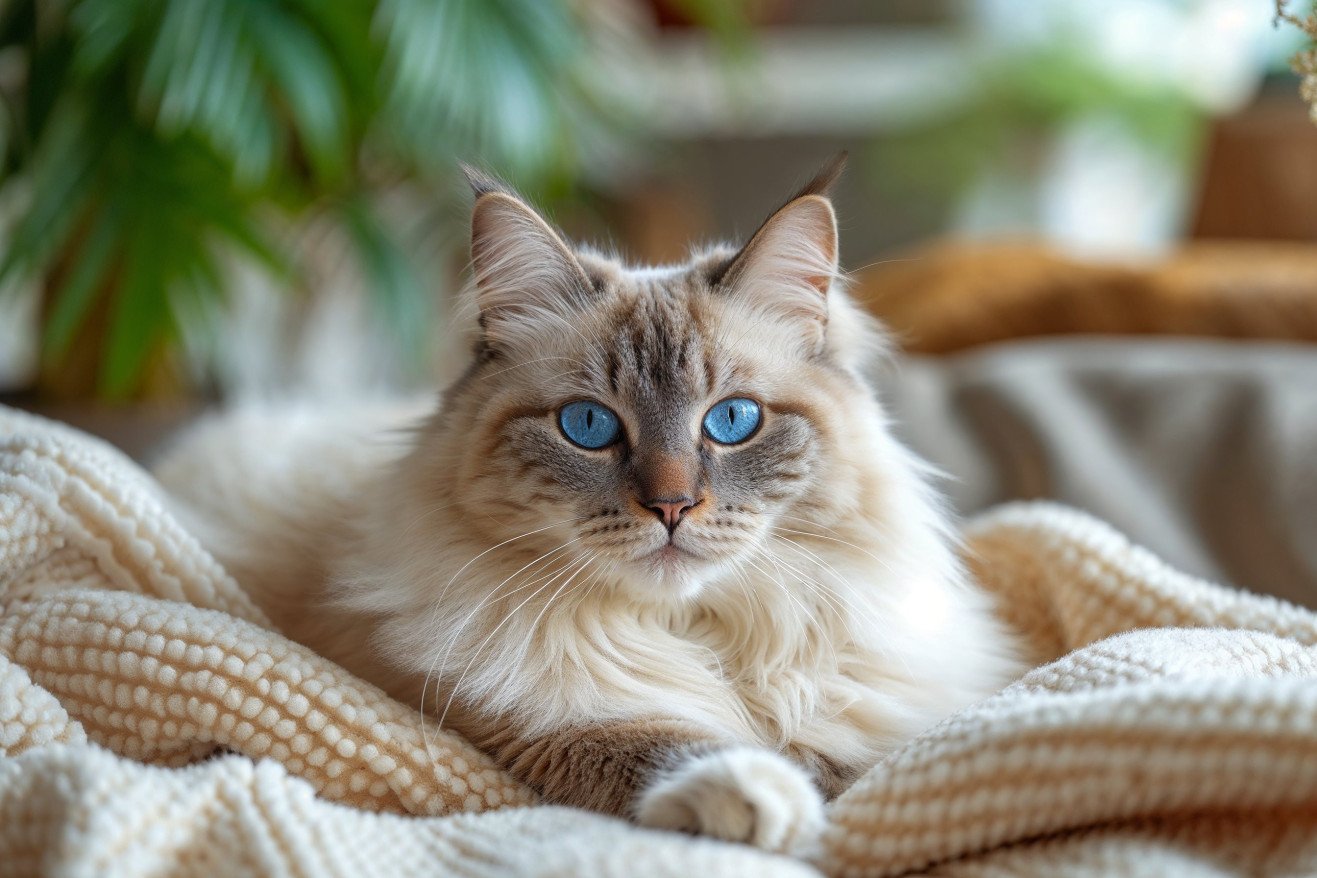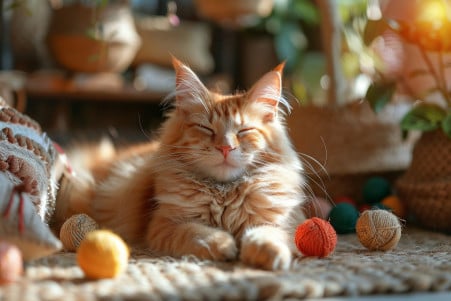How to Tell If Your Cat Is Happy: What Does a Happy Cat Look Like?
29 January 2024 • Updated 30 January 2024

While cats don’t smile in the same way that people do, they do show happiness in a number of other adorable ways. A happy cat will often purr, knead, and have a relaxed body with ears that are facing forward.
Other signs of a happy cat include slow blinking, a tail that is held high and moves gently, and a willingness to play. Regular grooming and a good appetite are also signs that a cat is happy.
This article will cover a wide range of studies from veterinary science, animal behavior, and feline psychology to give you a more in-depth understanding of how cats show that they are happy. We’ll look at research on body language, vocalizations, and daily behaviors to help you better understand the nuances of a happy cat. With this information, you can make sure that your furry friend is happy and purring in a supportive environment.
What are the most reliable indicators of a cat's happiness?
Understanding Cat Body Language
Cats’ body language is very nuanced and can give you a lot of insight into how they’re feeling. For example, a happy cat will often have a relaxed body posture and may be lying down with its paws tucked under its body or even exposing its belly.
In terms of tail language, a happy cat will have a tail that’s up in the air with a slight crook at the end. Whiskas notes that a tail that’s straight up in the air is a sure sign of a happy cat.
Ears and eyes are also very expressive; a happy cat will have ears that are facing forward with a slight tilt back. PetMD notes that a cat’s eyes will often show happiness with slow dilation and the slow blink.
These are just a few examples of the many ways that cats use body language to communicate their moods and feelings to those who speak their language. Understanding these signals helps us better understand our cats and form a more meaningful and empathetic relationship with them.
Vocalizations and Sounds of Contentment
In addition to body language, cats also communicate through a variety of vocalizations that can be described as a rich harmony of satisfaction.
The most classic of these is the purr, a rhythmic, soft, throaty sound that is the most well-known audible sign of a happy cat.
While purring is often a sign of happiness, it’s important to remember that it should always be taken in context, as cats will also purr when they are in pain or stressed.
In addition to these sounds, cats will also use chirps and trills to express happiness, often using them to invite their human to play or to express excitement when they see a bird outside.
These sounds, along with the conversational meows mentioned above, are used to help cats build and maintain their relationships with their human family members.
According to PetMD, cats will use these sounds to communicate with their human family members, often while looking directly at them and with a friendly, inquisitive expression. When we listen to these happy sounds, we can learn to understand and communicate with our cats more effectively, strengthening the bond between us and bringing happiness to both people and cats.
Behavioral Signs of a Happy Cat
A cat’s behavior is a complex language that can offer insight into how they’re feeling. For example, cats don’t just groom themselves to stay clean, they also do it to show that they feel safe and secure. When cats groom other cats, it’s an extension of this caregiving language and shows that they trust and care for the other cat, according to Whiskas.
Cats also show happiness and energy through play, whether they’re playing with a toy or another cat. Cats also show that they feel safe and secure in their environment by sleeping with their humans or other pets.
According to PetMD, a good sign that your cat is happy is that they have a good appetite and eat regularly. It’s also important to make sure that you’re keeping a consistent schedule and allowing your cat to engage in activities that are natural to them, like play that simulates hunting.
Feliway also says that environmental enrichment is important for promoting these behaviors and ensuring that your cat is happy. While it’s important to know what to look for in terms of contentment, it’s also important to know that not all behaviors are signs of happiness—excessive meowing or aggression during play can be signs of stress or discomfort.
That said, by understanding these behaviors, we can create an environment that’s supportive of our cats’ happiness and emotional well-being.
How a Cat’s Environment Affects Their Happiness
A cat’s environment has a huge impact on their emotional well-being. According to Fear Free Happy Homes, even small changes to a cat’s environment can make a big difference in their happiness.
In particular, a safe place to hide, like a comfortable carrier or a hiding spot, is not just a luxury but a necessity for a cat’s well-being. This is supported by WikiVet, which notes that a cat’s core territory is important for feelings of safety and security and for preventing stress.
The idea of a ‘catio,’ or an enclosed outdoor space, can also help enrich a cat’s life by providing them with environmental stimulation and a way to experience the outdoors in a safe way, according to Fear Free Happy Homes.
Smell is also important to a cat’s environment. Calming smells and familiar scents can help a cat feel more comfortable, while scent enrichment through catnip or silver vine can help a cat feel happier and more playful.
However, new environments or multi-cat households can be stressful for cats. Introducing cats slowly and keeping their scents separate can help make the transition easier and less stressful, so that each cat feels safe and secure in their new environment. By being mindful of a cat’s environment, we can create a space that not only meets their basic needs but also helps them feel happy.
The Secret Language of Whiskers: What Your Cat’s Expressions Mean
Cats have a complex range of emotions that they express through their faces, a secret language that has only recently been decoded. One of the most important breakthroughs in this area came when researchers created the Cat Facial Action Coding System (CatFACS), which identified 276 different facial movements in cats, according to National Geographic.
This tool shows that cats, who are often thought of as mysterious, actually have a wide range of emotions that they express through their minute facial movements.
More recently, a study published in PMC has shown that cats can recognize human emotions and even match human facial expressions with the sounds that correspond to them, even when the sound and the facial expression are from different senses. This means that cats are not only responding to visual cues but to auditory ones as well, and it shows a high level of emotional intelligence.
These discoveries have many important implications. For example, cat owners and professionals who know how to recognize these expressions can have more empathy and provide better care.
It also paves the way for better welfare practices in places like shelters, where recognizing the nuances of cat expressions can make a big difference in their well-being and their chances of being adopted. And it helps to deepen the relationship between cats and the people who love them, creating a relationship based on understanding and mutual respect.
Decoding the Purr-fect Signs of Happiness
In the complex world of cats, body language is the most common way that happiness is expressed, from the happy curve of a tail to the relaxed body position of lying down.
Sounds, from the comforting purr to the excited chirps, are another way that happiness is expressed.
Behaviors, from playing to social grooming, are also ways that cats show that they are happy. The physical environment is also important, with safe spaces and sensory enrichment being important parts of a cat’s happiness. By looking at the nuances of a cat’s facial expressions, we can see the emotional landscape that lies behind their mysterious eyes.
For cat parents, understanding these signs of happiness is more than just an academic exercise—it’s an important part of building a strong, empathetic relationship with our furry friends. This understanding can also help us make a real difference in our cats’ lives, improving their welfare and, in turn, the quality of our relationships with them.
As we conclude this adventure, let’s carry with us the understanding that a content cat is the core of a cheerful household. By learning to interpret the quiet indicators of contentment, we can forge a more robust connection with our cats.


